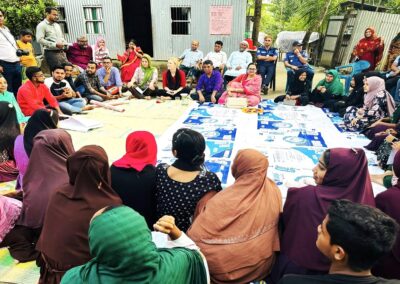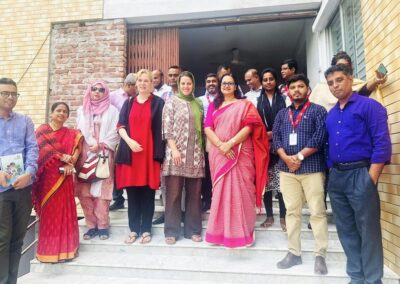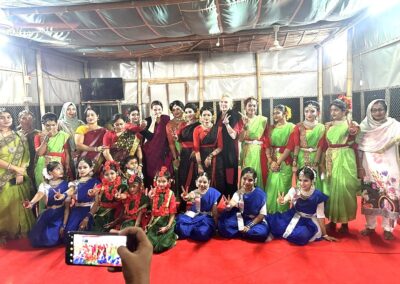Project Name: Youth Environmental Stewardship for Eco-Friendly Communities (YES4ECO)
Project Objective: To enhance the resilience, adaptive capacity to manage climate variability and environmental risk in the south coast of Bangladesh.
Project Goal: The overarching goal of the YES4ECO project is to enhance the resilience, adaptive capacity, and oversight of communities to manage climate variability and environmental risks in the south coast of Bangladesh, through the active and informed engagement of young people.
Project Brief: Bangladesh is one of the most climate‐affected countries in the world due to its flat typography, the precariousness of its river systems and high population density. It also experiences frequent natural disasters, with the southern part of the coastal belt being particular vulnerable. During a monitoring visit to southern Bangladesh in October 2022, Educo Bangladesh took Barnfonden to visit a youth group who proudly showed the work they were doing to safeguard their community from environmental risks. The risks in the low‐lying and exposed location where the youth lived, Barguna (population 848 5541 ), included natural hazards such as flood, cyclone, storm surge, salinity intrusion, excessive fog, temperature change, riverbank erosion, heavy rainfall, late rainy season and waterlogging,2 not to mention pollution and deforestation. These environmental risks were impacting their family’s livelihoods and security – in fact, many of the families who practice marginal and small‐scale farming (as per 84.27% of farmers in Bangladesh3 ) have already been forced to leave the area to mitigate to the slims of Dhaka to find alternative incomes (by 2050, one of seven people in Bangladesh are predicted to become climate migrants4 ). The youth also knew these risks affected their own futures, reducing opportunities for them to find jobs, access land and earn incomes. The youth Barnfonden met had come together under the auspices of Educo’s Grow Green to Protect the Planet (G2P) pilot project, to learn about the climate and environmental issues, map problems, and research and identify solutions. They engaged with local authorities, community members and farmers, and together came up with ideas for household smallholdings (averaging around 0.59 ha) to address the most pressing problems their community faced. They convinced some of their families to develop model demonstration farms to showcase improvements that could easily be made within these smallholdings, including the use of improved infrastructure and climate smart farming techniques. They also developed an advocacy campaign to address businesses and schools, to alert them to the risks of pollution, including the importance of reducing carbon emissions 5 and stopping tree‐felling. It was clear to the visiting Barnfonden representatives that these adolescents and youth had been nurtured as leaders: they had formulated innovative new concepts, and they were confident and clear about their ambitions and proud of their achievements to transform their village. While the concept for YES4ECO was presented to Postkod prior to Barnfonden’s visit based on the Educo’s experience with the G2P pilot intervention, the visit referred to above presented an opportunity for Barnfonden and Educo to, together, dig deeper into the methodology and approach. This full proposal of YES4ECO is based on lessons learned from spending time with the youth and members in the community, and with the local implementing partner. The lessons from G2P have been incorporated into the design of YES4ECO – a project which involves youth from other parts of Barguna. Important additions to the practical solutions devised by youth in the G2P pilot project that are embedded in the YES4ECO project design include the need to further link with other climate activist clubs and with government. Most government and non‐government disaster and environmental management processes exclude youth, despite their potential as change agents and despite the fact that it is the younger generation who face the future impacts of climate change. To addressthese challenges, the most cost‐effective and context appropriate approach isto engage in resilience building activities that are specific to the rural communities, and which also build on the strengths of these communities, using the energy and imagination of young people and tapping into the significant social capital that exists amongst the youth population. This group can play a powerful role in guiding community members and Upazila Parishad (a structure 1 Barguna District ‐ Banglapedia 2 Community Perception on Adverse Effects of Natural Hazards on Livelihood and Enhancing Livelihood Resiliency: A Case Study at Patharghata Upazila, Barguna ‐ ScienceDirect 3 Structural Changes of Farm Size and Labor’s Occupation in Bangladesh‐ A Markov Chain Analysis (degruyter.com) 4 How the Climate Crisis Is Impacting Bangladesh | Climate Reality Project 5 (PDF) GREENHOUSE GASES EMISSION IN THE RURAL AREAS OF COASTAL BARGUNA DISTRICT BANGLADESH (researchgate.net) 2 in which local government and elected officials work together to provide public services) and even district budgets in their community‐based climate adaptation and biodiversity improvement planning and budgeting processes. These duty bearers have a responsibility to uphold children’s right to a healthy and sustainable world, as is recognised in current work underway by the UN to develop General Comment 26 – a document (in draft) which provides authoritative guidance on how children’s rights are impacted by the environmental crisis. One in three children in the Bangladesh – nearly 20 million children – are already affected by climate change every day – a statistic that has generated a healthy national youth movement seeking action to deal with the environmental crisis 6 . Empowered by global imperatives, these supportive national networks can be used to guide, support and sustain community‐level youth action, and to link micro, meso and macro‐level social change. Currently, the southwest coastal region of Bangladesh does not have a harmonized set of interventions and actors working towards climate adaptation and biodiversity improvements. However, the Government of Bangladesh (GoB) has taken various policy initiativesto mobilize the public and non‐state actorsin working towards climate change adaptation, mitigation and disaster management at a national level. Some of the policy initiatives are: Management Act 2012, Disaster Management Policy, National Plan for Disaster Management 2015‐2020, Standing Orders on Disaster 2010 (revised in 2019) etc. Educo being a member of the National Displacement Management Cluster and Child Protection Cluster, coordinates with the GoB and the cluster members to learn and share the needs, solutions and technologies to addressthe climate vulnerability of the people, particularly children, adolescents and youth. Educo also coordinates with the Ministry of Disaster Management and Relief, Forestry and Environment. This project will also support the Strategy for Sweden’s Development Cooperation with Bangladesh 2021‐2025, and their ambition to build resilience to climate change and natural disasters and improve conditions for reduced environmental impact and the preservation and restoration of biodiversity. It also contributes to implementing the climate investment framework under Bangladesh Climate Change Strategy and Action Plan (BCCSAP7) and supports integration of climate change into development, specially target 18, 29, 310 and 411. It also strongly supports Barnfonden’s strategy which is focused on keeping children safe in a changing climate (Barnfonden_Strategic_Plan_2021‐2025‐LU.pdf).
Working Area: (Name Of Sub District, District.) Palerchar & Zajira Union, Zajira Upazila, Sub-Districts Zajira, District-Shariatpur.
Beneficiaries: The proposed project will directly benefit 2820 beneficiaries in 6 climate‐vulnerable communities in two subdistricts of Bangladesh. 5 The target group constitutes the following sub‐groups, which are further referred to in the activities: → 2,580 Adolescents and Youths (A&Y) of which 180 (90 boys and 90 girls), aged 12‐17 and 18‐24 will directly benefit from training on climate change and environmental stewardship. The 180 A&Y will be divided into six YES4ECO clubs (tree clubs in each district). These A&Y will then play a proactive role in changing behavior and practices of the community, while also networking with at least two other climate activist groups. In addition, 2,400 students (1,200 boys and 1,200 girls) of 12 Educational Institutions (06 primary and 06 secondary schools) in the targeted two districts will directly benefit from peer learning and knowledge strengthening on climate change and environmental issues. → At least 60 teachers (30 females and 30 males) from 12 educational institutions will be sensitized through awareness campaigns and by attending the environmental awareness sessions. → A total of 180 representatives of local authorities and ministries will directly participate in the proposed project (Union Parishad, Union Disaster Management Committee, Sub‐district Agriculture, Livestock and Fisheries departments). At micro level: Union Parisad will contribute to assessing and preparing action plans. They will also allocate funds to implement the action plan of A&Y as well as incorporate environmental issues identified in their development plans. The line departments will provide training to the farmers on new technologies. At meso‐Level: They will be supported with new ideas on climate change adaptation and biodiversity conservation and improvement, including being invited to field visits. At macro‐level: Good practices of the project will be shared to replicate in other areas. At least 600 participant households (a reach of 10,000 community members) are expected to be impacted by the initiatives through participating in assessments, awareness events and practices. And through social media activities, at least an organic reach of 100,000 people. The assets, structures and knowledge created by the initiative could be replicated in other communities, districts of the country and in future initiatives, and hence further benefit the population.
Major activities: • Adolescent and youth (A&Y) are equipped with concepts, capacity, connections and leadership to mobilize their communities in understanding climate change and practicing environmental stewardship. • Strengthened capacity of Adolescents and Youth who are cognisant of theirrightsto implement integrated Climate Change Adaptation & Environmental Stewardship plans and projects in their local communities. • Eco‐friendly and community‐based adaptation interventions identified for building resilience (based on a youth‐led process using a participatory method *climate‐ now, soon and future*.





